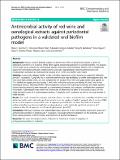Por favor, use este identificador para citar o enlazar a este item:
http://hdl.handle.net/10261/184651COMPARTIR / EXPORTAR:
 SHARE SHARE
 CORE
BASE CORE
BASE
|
|
| Visualizar otros formatos: MARC | Dublin Core | RDF | ORE | MODS | METS | DIDL | DATACITE | |

| Campo DC | Valor | Lengua/Idioma |
|---|---|---|
| dc.contributor.author | Sánchez, María C. | - |
| dc.contributor.author | Ribeiro-Vidal, Honorato | - |
| dc.contributor.author | Esteban-Fernández, Adelaida | - |
| dc.contributor.author | Bartolomé, Begoña | - |
| dc.contributor.author | Figuero, Elena | - |
| dc.contributor.author | Moreno-Arribas, M. Victoria | - |
| dc.contributor.author | Sanz, Mariano | - |
| dc.contributor.author | Herrera, David | - |
| dc.date.accessioned | 2019-06-23T03:42:04Z | - |
| dc.date.available | 2019-06-23T03:42:04Z | - |
| dc.date.issued | 2019-06-21 | - |
| dc.identifier.citation | BMC Complementary and Alternative Medicine 19(1): 145 (2019) | - |
| dc.identifier.uri | http://hdl.handle.net/10261/184651 | - |
| dc.description.abstract | [Background] Previous research findings support an antimicrobial effect of polyphenols against a variety of pathogens, but there is no evidence of this effect against periodontal pathogens in complex biofilms. The purpose of this study was to evaluate the antimicrobial activity of red wine and oenological extracts, rich in polyphenols, against the periodontal pathogens Porphyromonas gingivalis, Aggregatibacter actinomycetemcomitans and Fusobacterium nucleatum and total bacteria growing in an in vitro oral biofilm static model. | - |
| dc.description.abstract | [Methods] A previously validated biofilm model, including Streptococcus oralis, Actinomyces naeslundii, Veillonella parvula, F. nucleatum, P. gingivalis and A. actinomycetemcomitans was developed on sterile hydroxyapatite discs. Red wine (and dealcoholized wine), and two polyphenols-rich extracts (from wine and grape seeds) were applied to 72 h biofilms by dipping the discs during 1 and 5 min in the wine solutions and during 30 s and 1 min in the oenological extracts. Resulting biofilms were analyzed by confocal laser scanning microscopy and viable bacteria (colony forming units/mL) were measured by quantitative polymerase chain reaction combined with propidium monoazide. A generalized linear model was constructed to determine the effect of the tested products on the viable bacterial counts of A. actinomycetemcomitans, P. gingivalis and F. nucleatum, as well on the total number of viable bacteria. | - |
| dc.description.abstract | [Results] The results showed that red wine and dealcoholized red wine caused reduction in viability of total bacteria within the biofilm, with statistically significant reductions in the number of viable P. gingivalis after 1 min (p = 0.008) and in A. actinomycetemcomitans after 5 min of exposure (p = 0.011) with red wine. No evidence of relevant antibacterial effect was observed with the oenological extracts, with statistically significant reductions of F. nucleatum after 30 s of exposure to both oenological extracts (p = 0.001). | - |
| dc.description.abstract | [Conclusions] Although moderate, the antimicrobial impact observed in the total bacterial counts and counts of A. actinomycetemcomitans, P. gingivalis and F. nucleatum, encourage further investigations on the potential use of these natural products in the prevention and treatment of periodontal diseases. | - |
| dc.description.sponsorship | A.E-F is the recipient of fellowship from the FPI-MINECO programme. This work was funded by the Spanish MINECO (AGL2015–64522-C2-R project) and Comunidad de Madrid (ALIBIRD-CM S2013/ABI-2728). | - |
| dc.language.iso | en | - |
| dc.publisher | BioMed Central | - |
| dc.relation | S2013/ABI-2728/ALIBIRD-CM | - |
| dc.relation | info:eu-repo/grantAgreement/MINECO/Plan Estatal de Investigación Científica y Técnica y de Innovación 2013-2016/AGL2015-64522-C2-R | - |
| dc.relation.isversionof | Publisher's version | - |
| dc.rights | openAccess | - |
| dc.subject | Red wine | - |
| dc.subject | Oenological extracts | - |
| dc.subject | Polyphenols | - |
| dc.subject | Periodontal diseases | - |
| dc.subject | P. gingivalis | - |
| dc.subject | A. actinomycetemcomitans | - |
| dc.subject | F. nucleatum | - |
| dc.title | Antimicrobial activity of red wine and oenological extracts against periodontal pathogens in a validated oral biofilm model | - |
| dc.type | artículo | - |
| dc.identifier.doi | 10.1186/s12906-019-2533-5 | - |
| dc.description.peerreviewed | Peer reviewed | - |
| dc.relation.publisherversion | https://doi.org/10.1186/s12906-019-2533-5 | - |
| dc.identifier.e-issn | 1472-6882 | - |
| dc.date.updated | 2019-06-23T03:42:05Z | - |
| dc.rights.license | http://creativecommons.org/licenses/by/4.0/ | - |
| dc.contributor.funder | Ministerio de Economía y Competitividad (España) | - |
| dc.contributor.funder | Comunidad de Madrid | - |
| dc.relation.csic | Sí | - |
| dc.identifier.funder | http://dx.doi.org/10.13039/100012818 | es_ES |
| dc.identifier.funder | http://dx.doi.org/10.13039/501100003329 | es_ES |
| dc.identifier.pmid | 31226983 | - |
| dc.type.coar | http://purl.org/coar/resource_type/c_6501 | es_ES |
| item.cerifentitytype | Publications | - |
| item.openairecristype | http://purl.org/coar/resource_type/c_18cf | - |
| item.grantfulltext | open | - |
| item.openairetype | artículo | - |
| item.fulltext | With Fulltext | - |
| item.languageiso639-1 | en | - |
| Aparece en las colecciones: | (CIAL) Artículos | |
Ficheros en este ítem:
| Fichero | Descripción | Tamaño | Formato | |
|---|---|---|---|---|
| antimicrobial_activity_red_wine_oenological_extracts.pdf | 11,64 MB | Adobe PDF |  Visualizar/Abrir |
CORE Recommender
PubMed Central
Citations
18
checked on 11-abr-2024
SCOPUSTM
Citations
26
checked on 24-abr-2024
WEB OF SCIENCETM
Citations
27
checked on 26-feb-2024
Page view(s)
411
checked on 26-abr-2024
Download(s)
249
checked on 26-abr-2024

